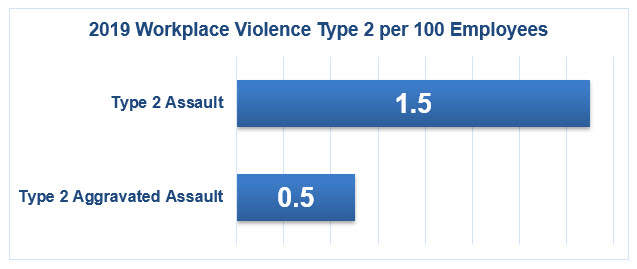Comparing Your Hospital to the 2020 Healthcare Crime Survey
For comparison purposes, it might be beneficial to compare your hospital’s crime rates to those presented above. The formula to calculate the crime rate per 100 beds is:
Crime Rate = (x / Beds) * 100
where x is the total crime for each crime type and
Beds is the number of beds at your hospital
Example: (17 assaults / 360 beds) = 0.047 * 100 = 4.7 assaults per bed
As mentioned earlier in this report, the use of crime rates provides context and allow for comparisons to other hospitals. Bed counts were used based on experience from prior crime surveys where additional size and population indicators were collected. That experience informed the decision to use bed counts as other indicators were more challenging to obtain and not consistently reported via the crime surveys.
Workplace Violence Typology
For Aggravated Assaults and Assaults, participants were asked to drill down further, if possible, into the FBI’s workplace violence typology:
- Workplace Violence Type 1: Violent acts by criminals, who have no other connection with the workplace, but enter to commit robbery or another crime.
- Workplace Violence Type 2: Violence directed at employees by customers, clients, patients, students, inmates, or any others for whom an organization provides services.
Examples: patient-on-staff; visitor-on-staff - Workplace Violence Type 3: Violence against coworkers, supervisors, or managers by a present or former employee.
Examples: physician-on-nurse; employee-on-employee - Workplace Violence Type 4: Violence committed in the workplace by someone who doesn’t work there, but has a personal relationship with an employee—an abusive spouse or domestic partner.
Many respondents (n = 104) provided aggravated assault and assault data by workplace violence type. As found in prior Healthcare Crime Surveys, Workplace Violence Type 2 continues to dominate the other types of workplace violence and is increasing. Workplace Violence Type 2 aggravated assaults accounted for 78% of all aggravated assaults and 85% of all assaults in U.S. hospitals. For simplicity, the graph below displays each Workplace Violence Type with aggravated assaults and assaults combined.

To drill down on Workplace Violence Type 2 incidents, the survey also collected information on the number of employees who worked at the hospital. The responses (n = 104) to this question allowed us to calculate the number of Workplace Violence Type 2 incidents per 100 employees. The graph below displays the 2019 rate of assaults and aggravated assaults against employees by patients or visitors per 100 employees.

Workplace Violence Type 2 increased in 2019 compared to 2018 when the Type 2 Assault and Aggravated Assault Rates were 1.2 and 0.2 per 100 Employees, respectively.
For the 2020 Healthcare Crime Survey, we also asked if the hospital has an Inpatient Behavioral Health / Psychiatric Unit. The purpose of this question was to determine if hospitals with such units experienced differences in Workplace Violence Type 2 incidents.
Of the hospitals that responded to this question and collected information consistent with the Workplace Violence Typology (n = 102), 41% had an Inpatient Behavioral Health / Psychiatric Unit and 59% did not have such a unit. These hospitals experienced virtually no difference in Workplace Violence Type 2 incidents.
Walk Through Metal Detectors
For this year’s Healthcare Crime Survey, we asked participants if they used walk-through (free standing) metal detectors to screen visitors and patients as they entered the hospital 24 hours a day / 7 days a week. For those that had walk-through metal detectors operational 24/7, we also asked about the impact of these devices on crime, security incidents, and workplace violence.

As seen in the graph, eight percent (n = 19) of participant hospitals used walk-through metal detectors 24/7 in 2019. Three hospitals reported no impact on crime, security incidents, or workplace violence. The remaining hospitals with these devices reported a positive impact on crime, security incidents, and workplace violence. Some hospitals reported a decline in theft and the removal of weapons and weaponizable items (e.g. sharps, screw drivers, etc.) from patients and visitors resulting from the use of walk-through metal detectors. This information should be used cautiously as only a few hospitals reported positive impacts and specific details.
Canine Program
In addition to the metal detector question, we also asked participants if they had a canine program and the impact of the canine program on crime, security incidents, and workplace violence.

As seen in the graph, six percent (n = 15) of participant hospitals had a canine program in 2019. Three hospitals reported no impact on crime, security incidents, and/or workplace violence, though two of these hospitals had only recently implemented the canine program. Two hospitals reported successful de-escalation of volatile situations and a decrease in workplace violence as a result of their canine programs. Here again, this information should be used cautiously as only a few hospitals reported positive impacts and specific details.
